AMD Radeon RX 5500 XT 4GB vs. 8GB
As promised in our mean solar day-1 Radeon RX 5500 XT review, today we're taking a look at the 4GB version to see how it performs and more importantly how it compares to not but 8GB models, only also other graphics cards that compete in the same price range similar the RX 580. On hand for testing we have the Sapphire Pulse RX 5500 XT 4G and Pulse RX 5500 XT 8G, both of which come in cute little boxes.
What'due south cracking about using these cards for a 4GB vs. 8GB exam, is that with the exception of memory chapters, they're identical, so there are no other factors to account for such as cooler quality or operating clock speeds that can influence the results.
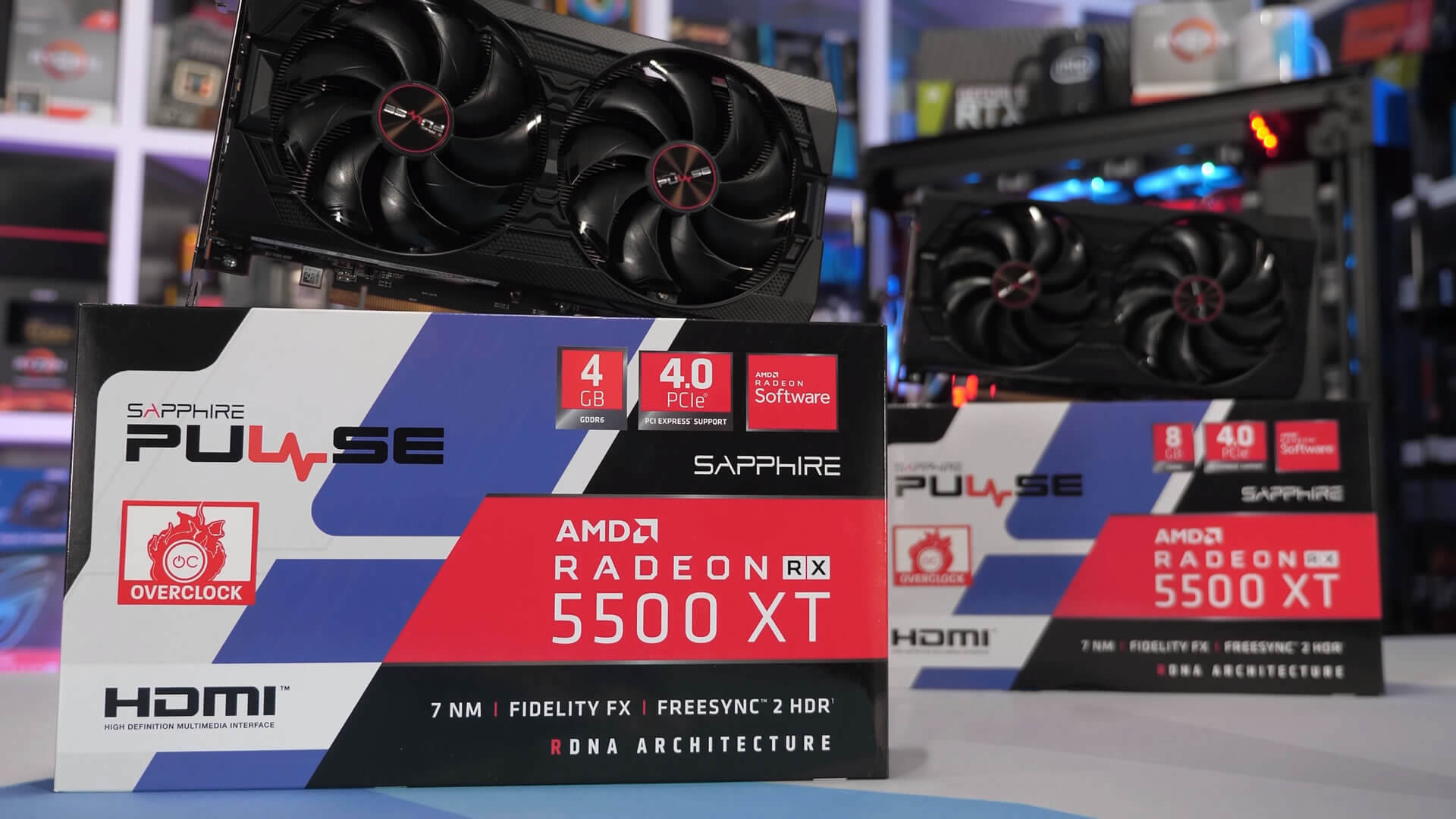
The Sapphire Pulse 5500 XT's are also acme notch cards that retail for most $10 over the MSRP, a reasonable markup given they feature a factory overclock, a well designed cooler with an excellent aluminium backplate, and they fifty-fifty come with a dual BIOS. They're likewise relatively compact dual-slot cards that measure just 233mm long.
The test arrangement used includes a Core i9-9900K clocked at 5 GHz with 16GB of DDR4-3400 retentiveness. Same as our previous review, we have 12 games to look at, all tested at 1080p and 1440p resolutions using medium to high quality presets or settings, so let's go into the results.
Benchmarks
Get-go upwardly we have Shadow of the Tomb Raider and here the 4GB 5500 XT was 10% slower than the 8GB version when looking at the average frame charge per unit and that meant it was no faster than the RX 580 and half dozen% slower than the RX 590. It was too on par with the GTX 1650 Super, averaging just 2 fps more for a mere 3% performance increase.
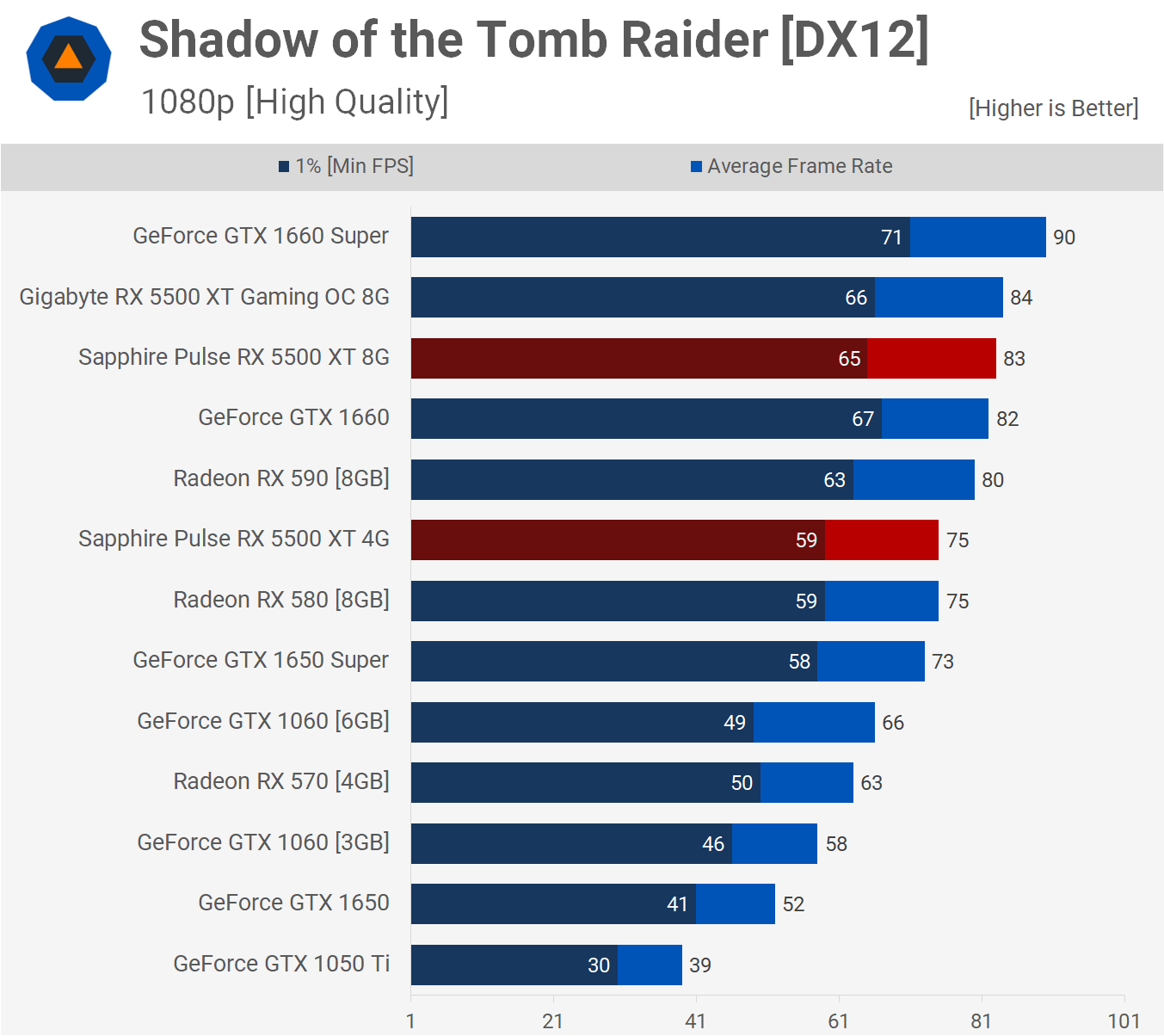
Increasing the resolution to 1440p doesn't change much. The 4GB version was eleven% slower this time and again that placed it on par with the RX 580 and slightly alee of the GTX 1650 Super.


The operation driblet off for the 4GB version in Assassinator's Creed Odyssey at 1080p is pretty minimal, that said performance wise it'due south too comparable to the GTX 1650 Super.
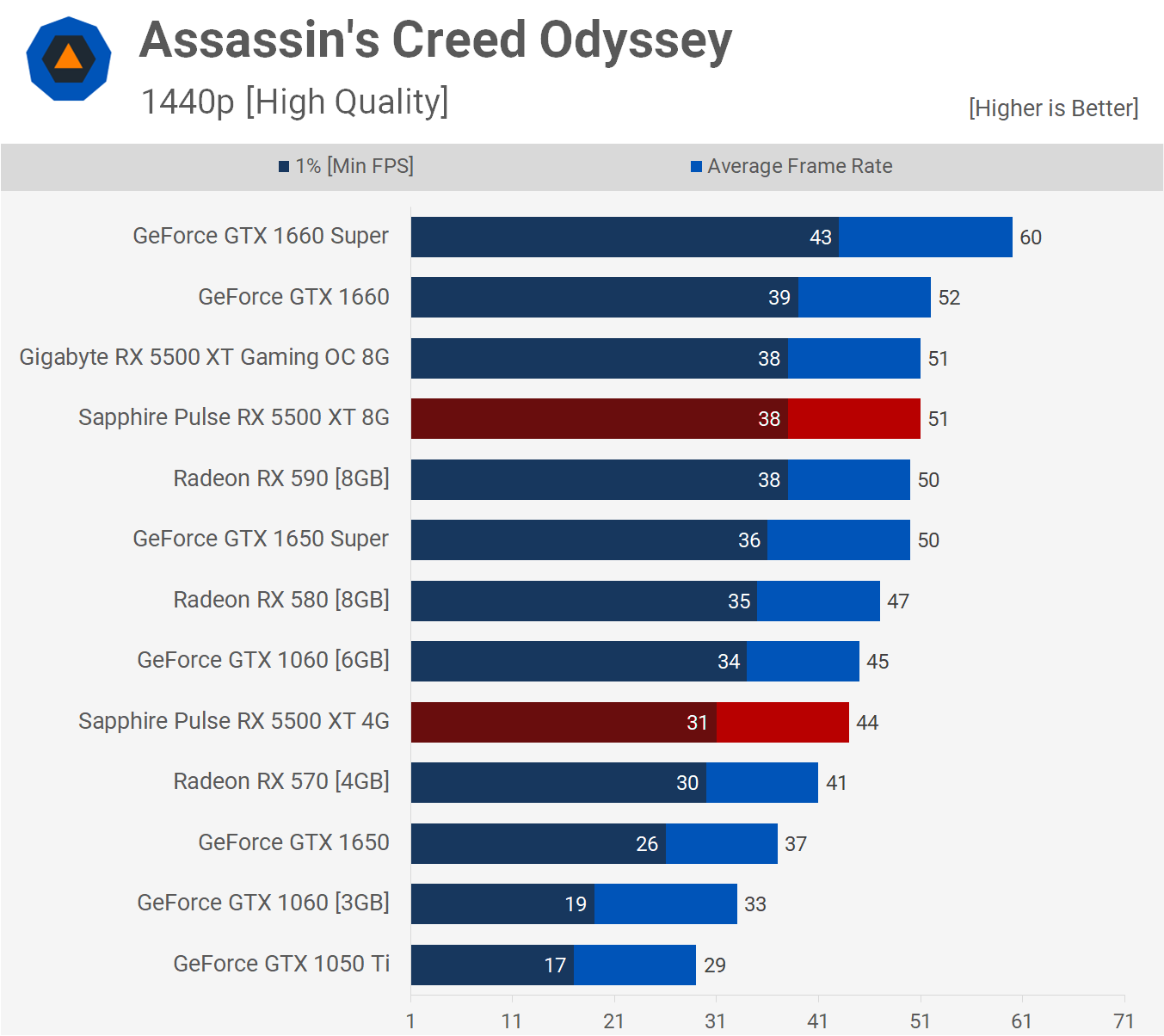
Interestingly, the move to 1440p does see a meaning reduction in performance for the 4GB 5500 XT, and that'due south interesting because the 1650 Super doesn't announced to suffer nearly as much. Equally a effect, the 4GB 5500 XT was 12% slower than the 1650 Super. Basically under these conditions y'all're looking at RX 570 level of functioning.
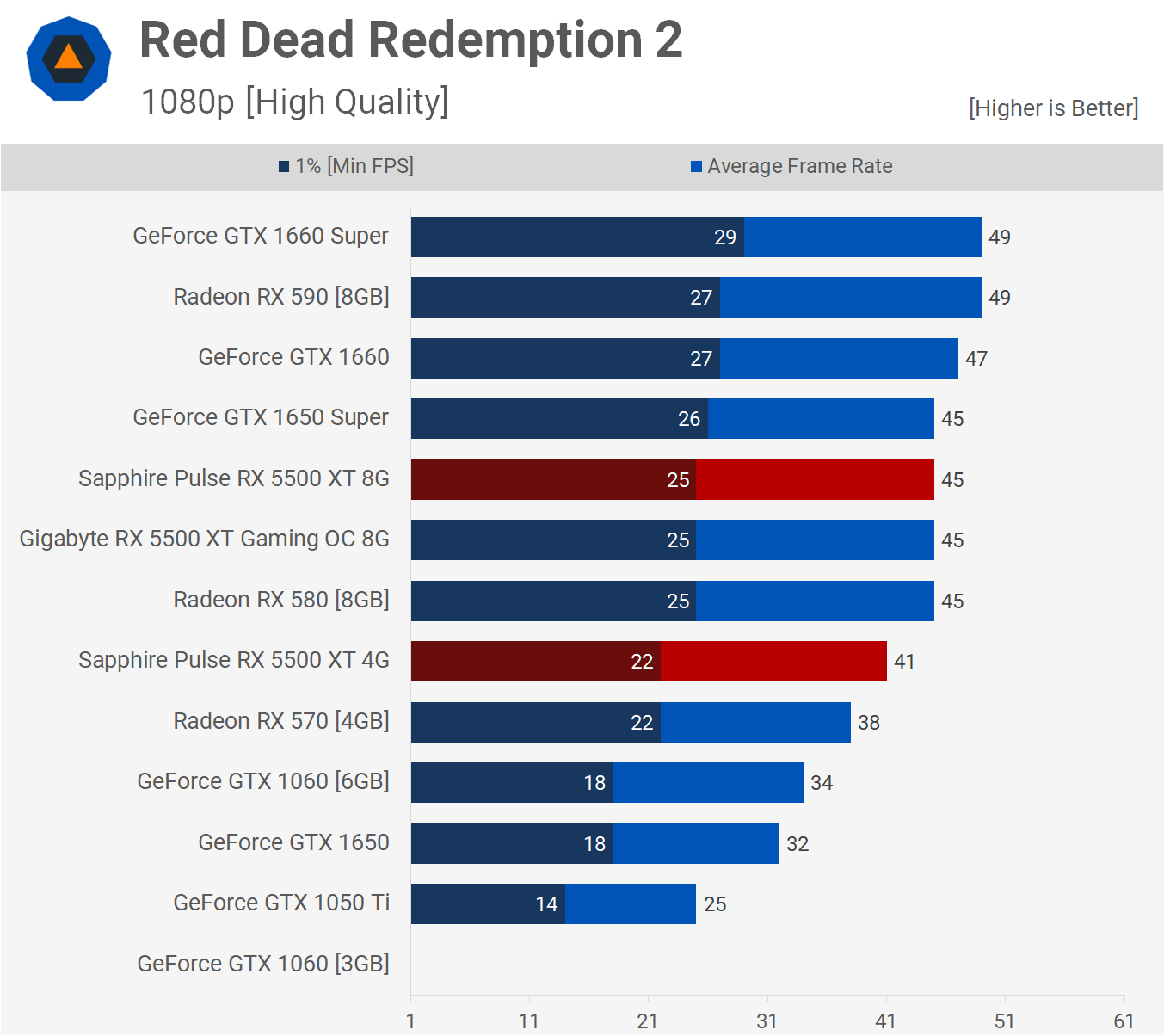

We'll have to update the Red Dead Redemption two test for these lower-end GPUs with medium to low quality settings in the well-nigh future, loftier is but too much for this course of GPUs. At 1080p the 4GB 5500 XT sees a nine% performance hit, which isn't great and that too makes it 9% slower than the 1650 Super.
Although the 4GB 5500 XT also takes a hit at 1440p, we retrieve the biggest performance bottleneck here are the GPUs themselves, and so in other words the GPUs are choking earlier VRAM capacity becomes a serious issue.

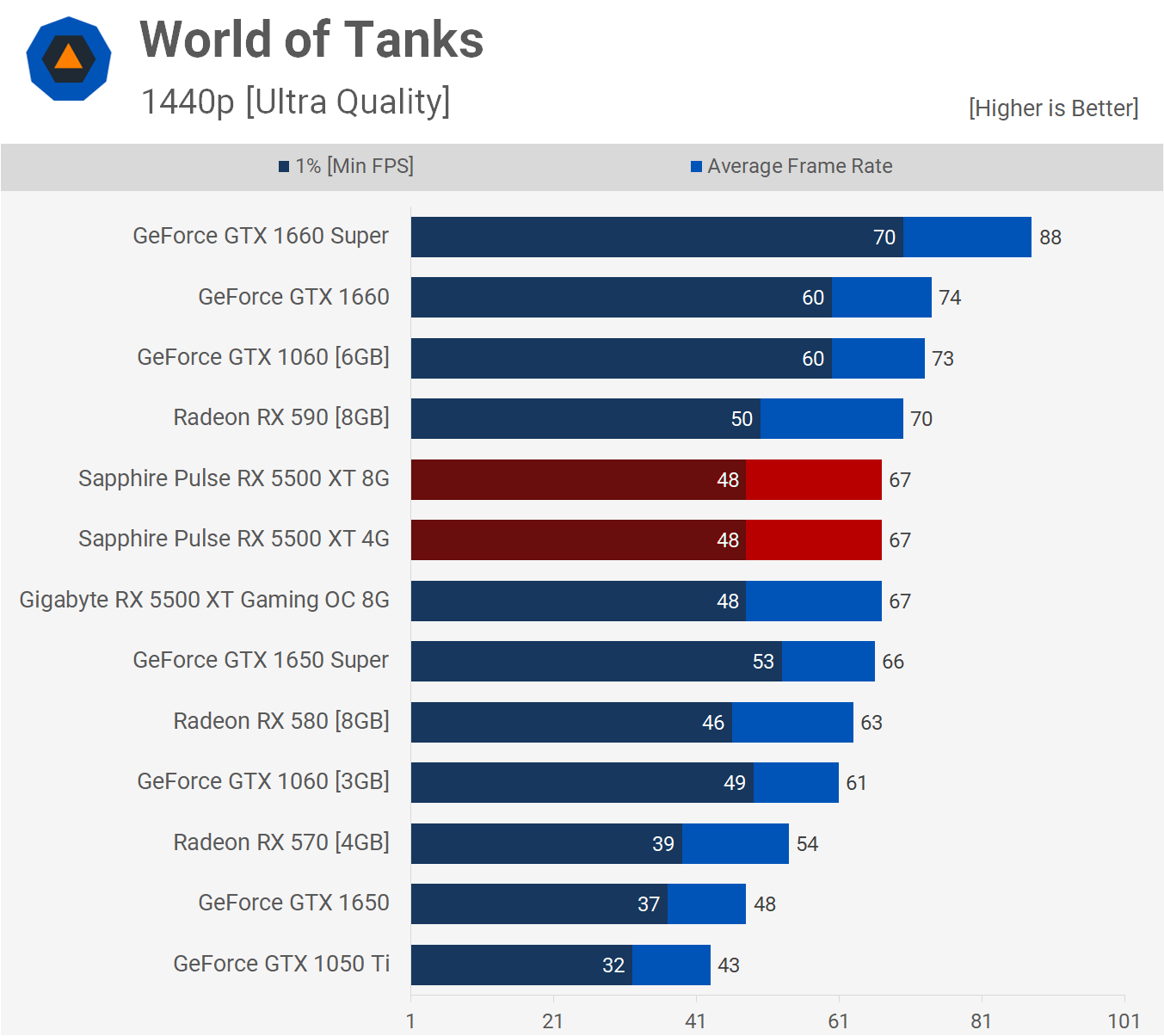
Moving on to World of Tanks, this game merely allocates around 3GB of VRAM at 1440p using the maximum in-game quality settings with the HD client version. Thus at 1080p we see no divergence between the 4GB and 8GB versions of the 5500 XT.
It'due south the same story at 1440p, with up to just 3GB of memory allocated, both the 4GB and 8GB versions deliver the same level of performance.


The 4GB 5500 XT drops a few frames when compared to the 8GB model in Far Cry New Dawn, simply overall operation at 1080p using the second highest quality preset is still very good.
Much the aforementioned is seen at 1440p. We're using the 2nd highest quality preset and despite that the 4GB 5500 XT is however able to average but over 60fps.

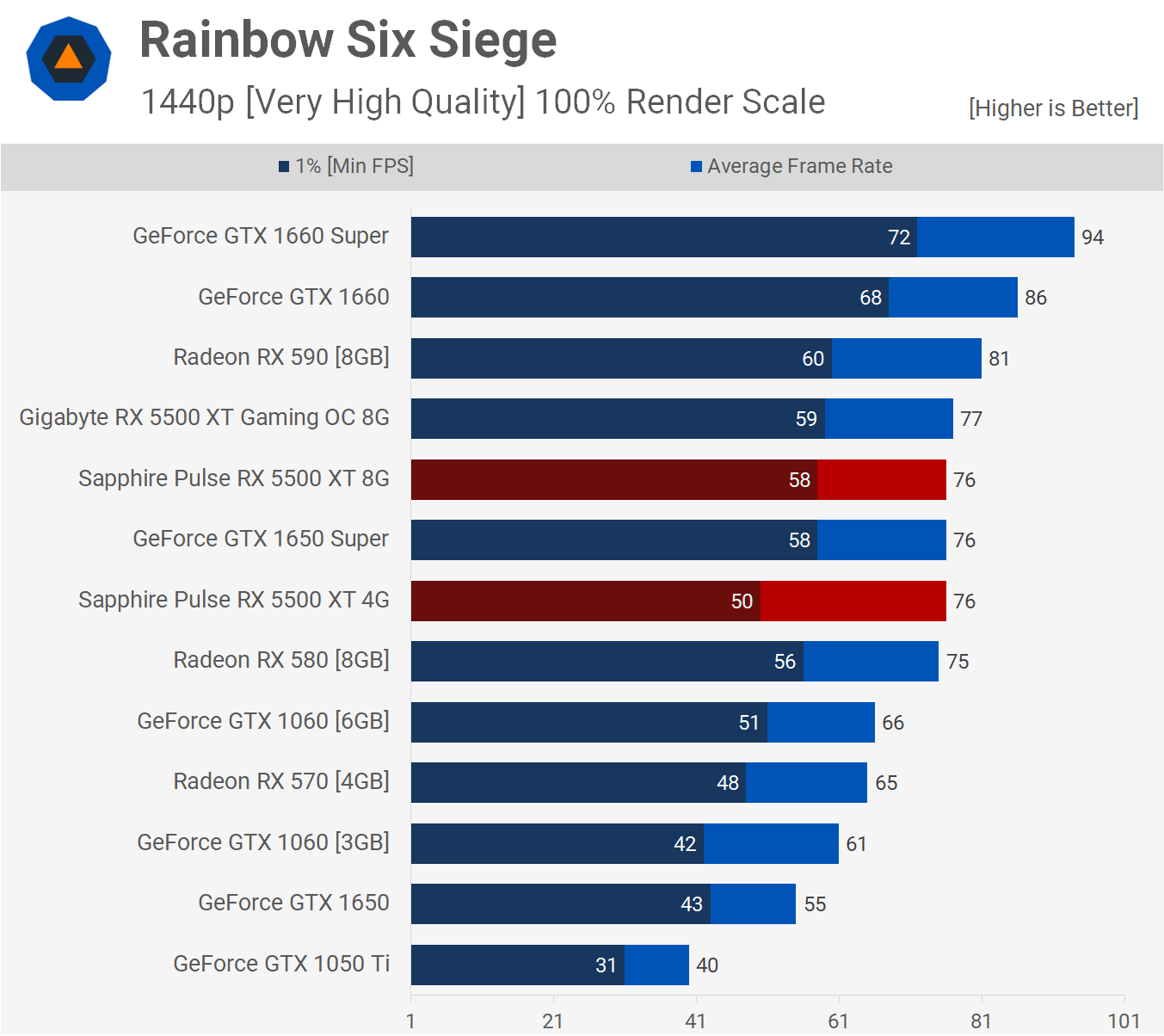
We're not playing Rainbow Vi Siege with the highest visual quality settings, rather the second quality preset with a manual render calibration of 100% set. This saw the 4 and 8 GB 5500 XT models evangelize the same 128 fps on average at 1080p.
Even at 1440p nosotros encounter the same average frame charge per unit. However, it'due south the 1% low functioning that falls away with the 4GB model and while information technology'southward withal very playable, this cut down version wasn't quite as smooth overall.


Side by side up nosotros accept Star Wars Jedi: Fallen Order and at 1080p using the high quality preset which is one stride beneath the max 'Ultra' setting, we see no difference in performance between the 4GB and 8GB versions of the 5500 XT.
At 1440p functioning we observe the same performance. In this game the Radeon 5500 XT delivered basically the aforementioned level of operation as the 1650 Super and even the 3GB GTX 1060.
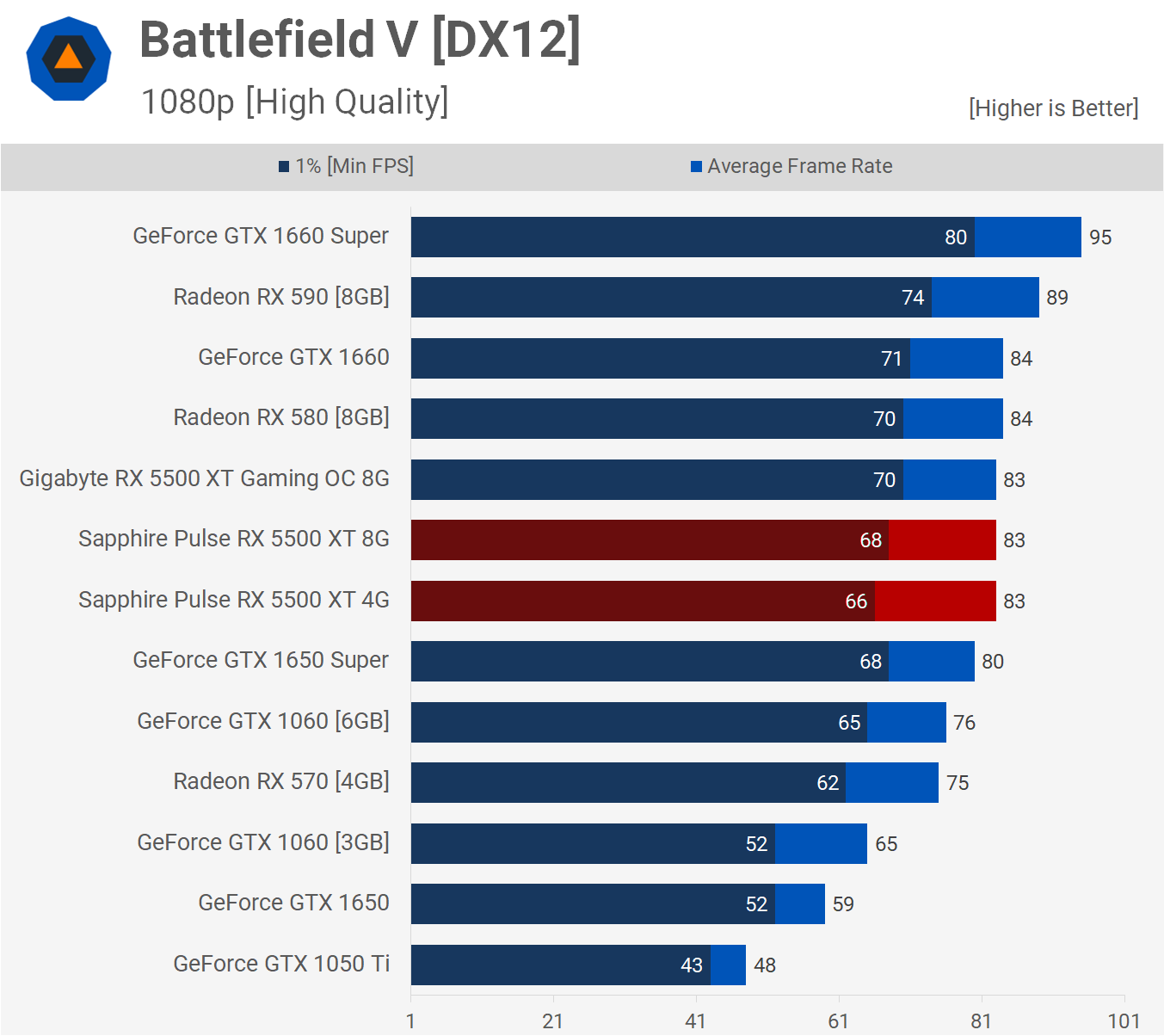
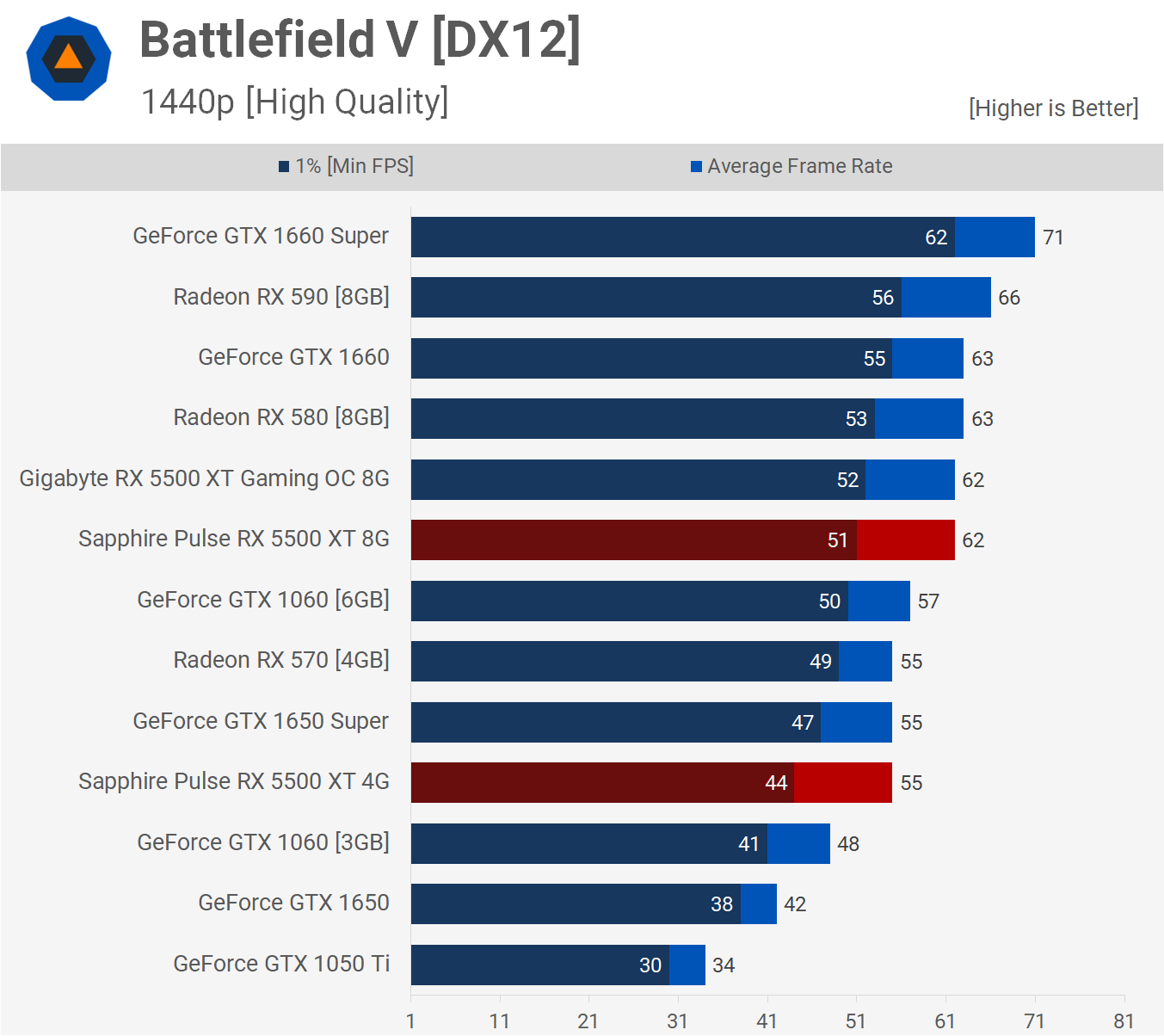
In Battlefield 5 the 4GB 5500 XT was able to keep pace with the 8GB version at 1080p, both rendering 83 fps on average, which is essentially the same level of performance y'all'll receive from the RX 580.
However, the story changes at 1440p where the 4GB 5500 XT struggles and the average frame rate drops by eleven%. This ways the 5500 XT was now just able to match the 1650 Super and RX 570.

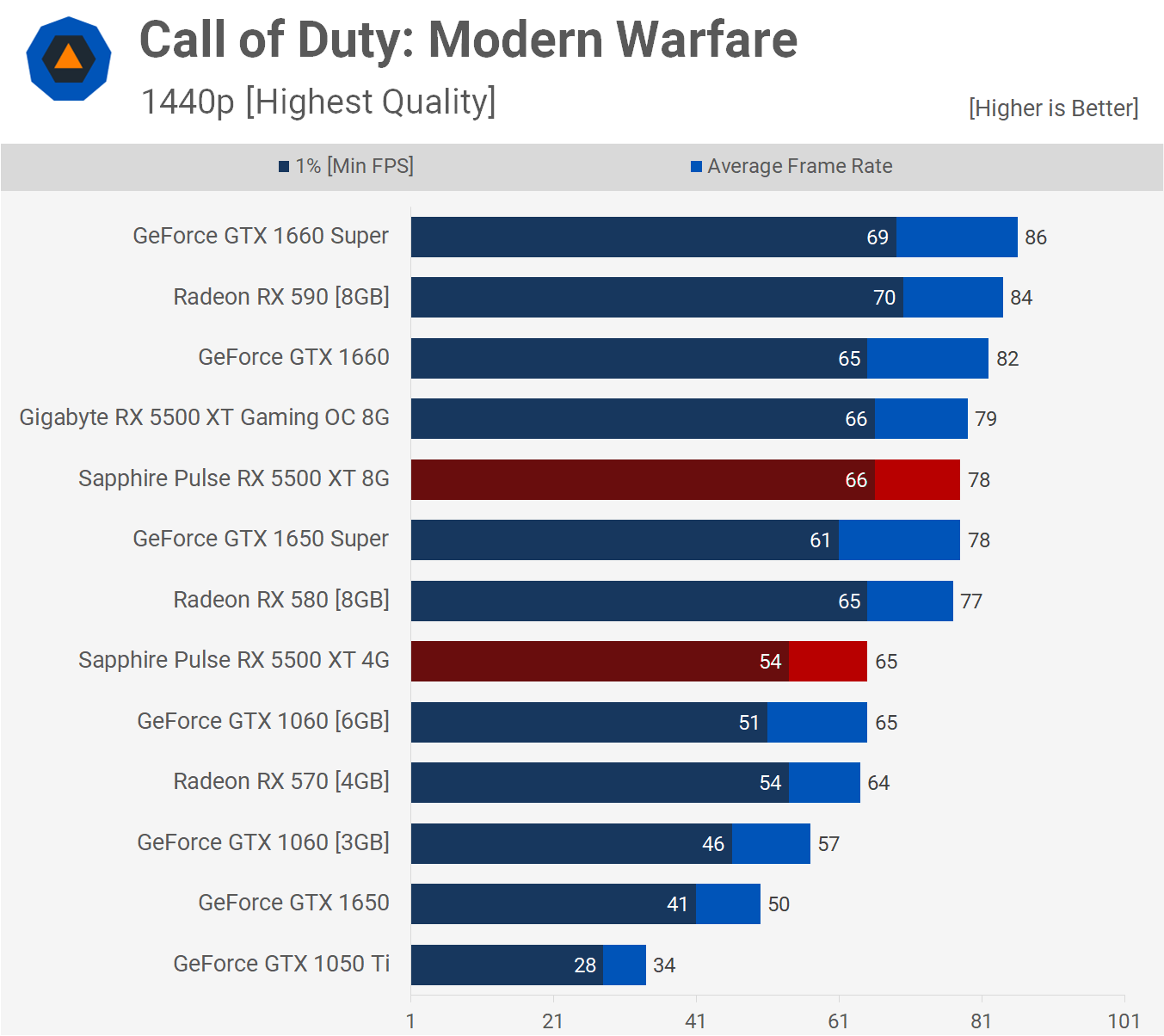
Telephone call of Duty: Modern Warfare is memory hungry even at 1080p, though we are using the highest possible quality settings. The 4GB 5500 XT averaged an impressive 96 fps, merely that was nevertheless 15% behind the 8GB version, as well equally Nvidia'due south GTX 1650 Super.
The drib off at 1440p was but equally harsh. Here the 4GB version was 17% slower and once more the 4GB 1650 Super didn't suffer the same fate which is interesting. Again yous're looking at RX 570-like performance with the 4GB 5500 XT in this title.
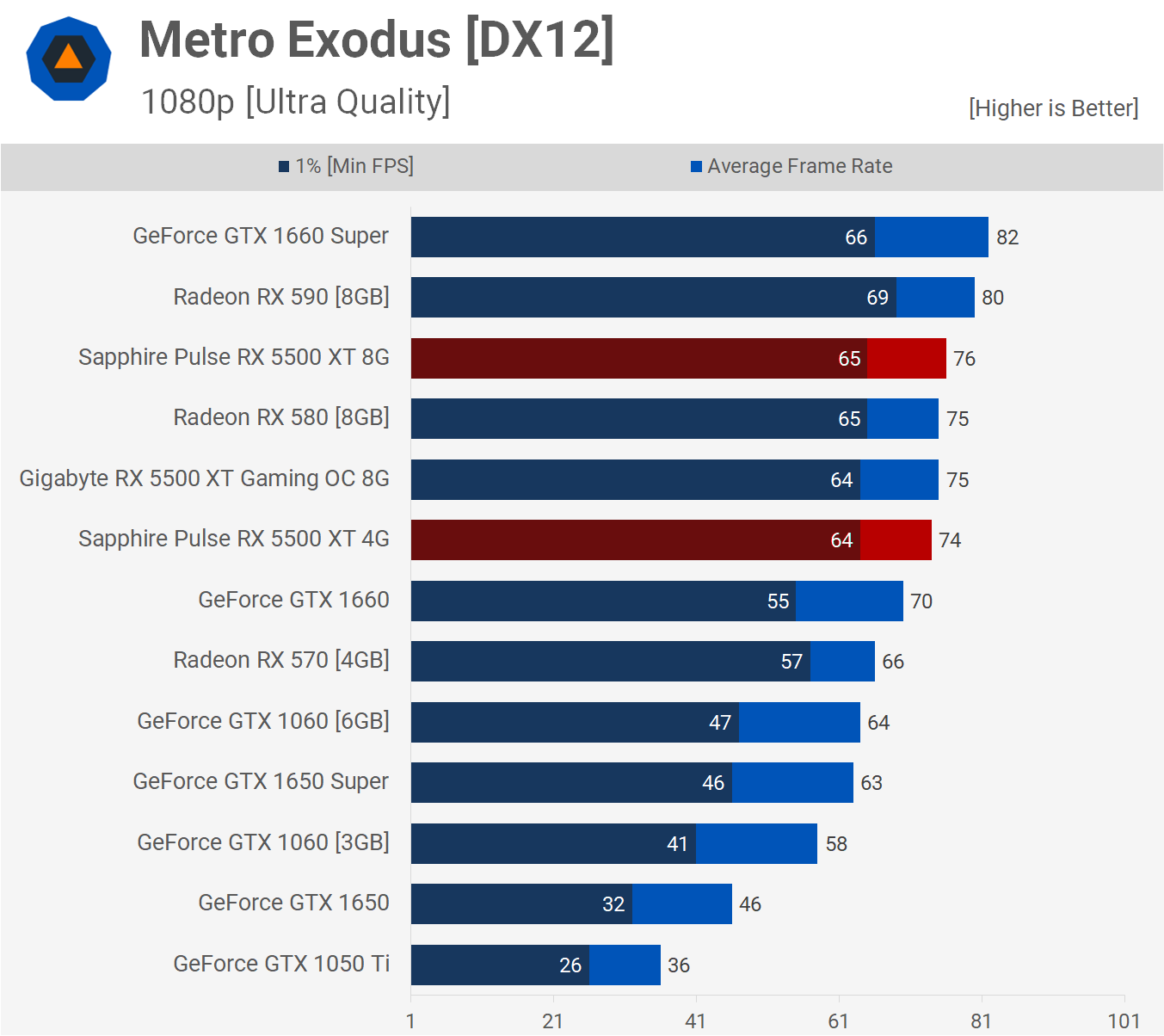
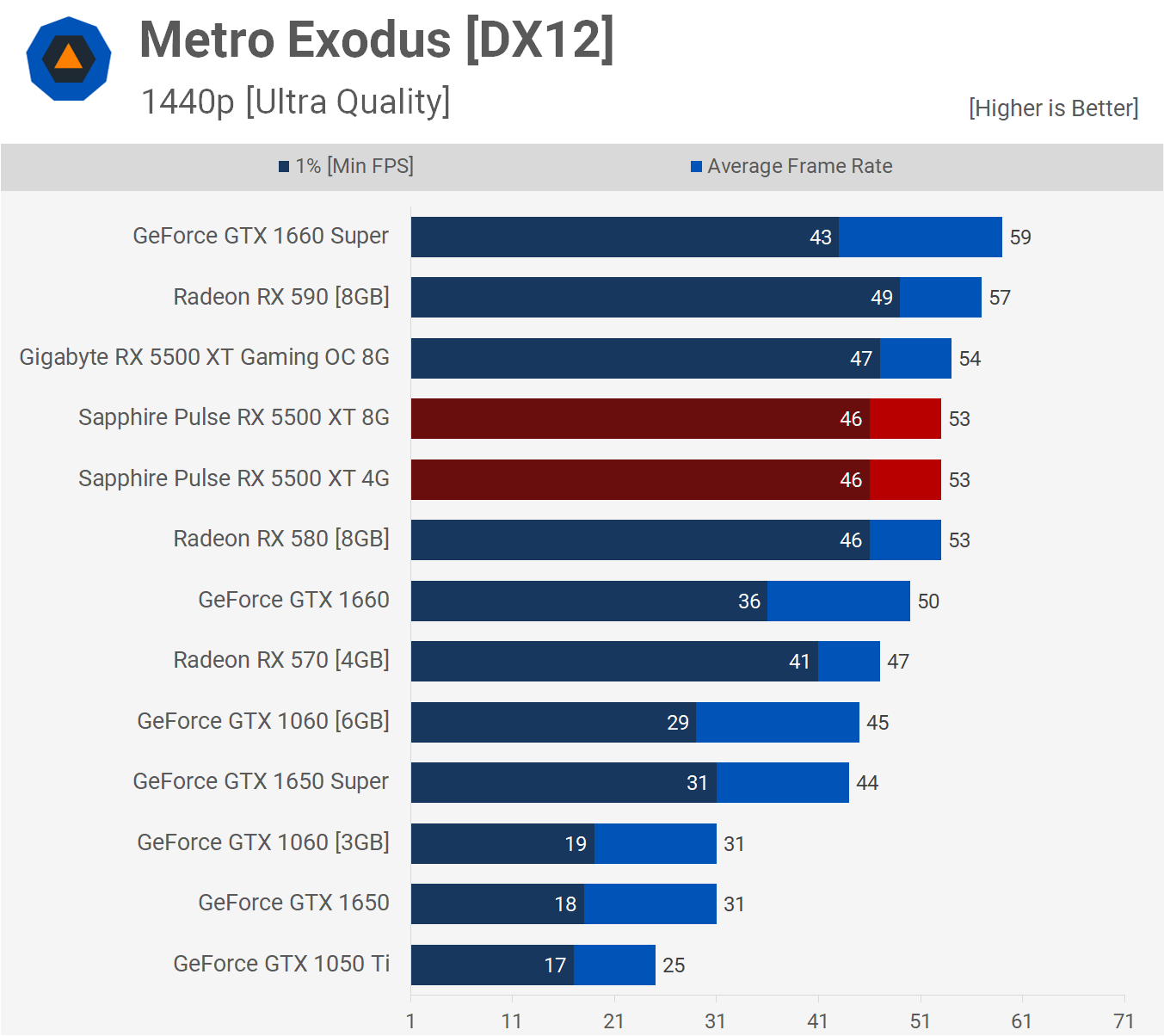
Testing with Metro Exodus using the ultra quality settings, the 4GB 5500 XT hangs in there rather well, matching the 8GB version besides as the 8GB RX 580. We see much the same at 1440p and this time the 4GB 5500 XT was miles faster than the GTX 1650 Super, producing ~20% more than frames on average.
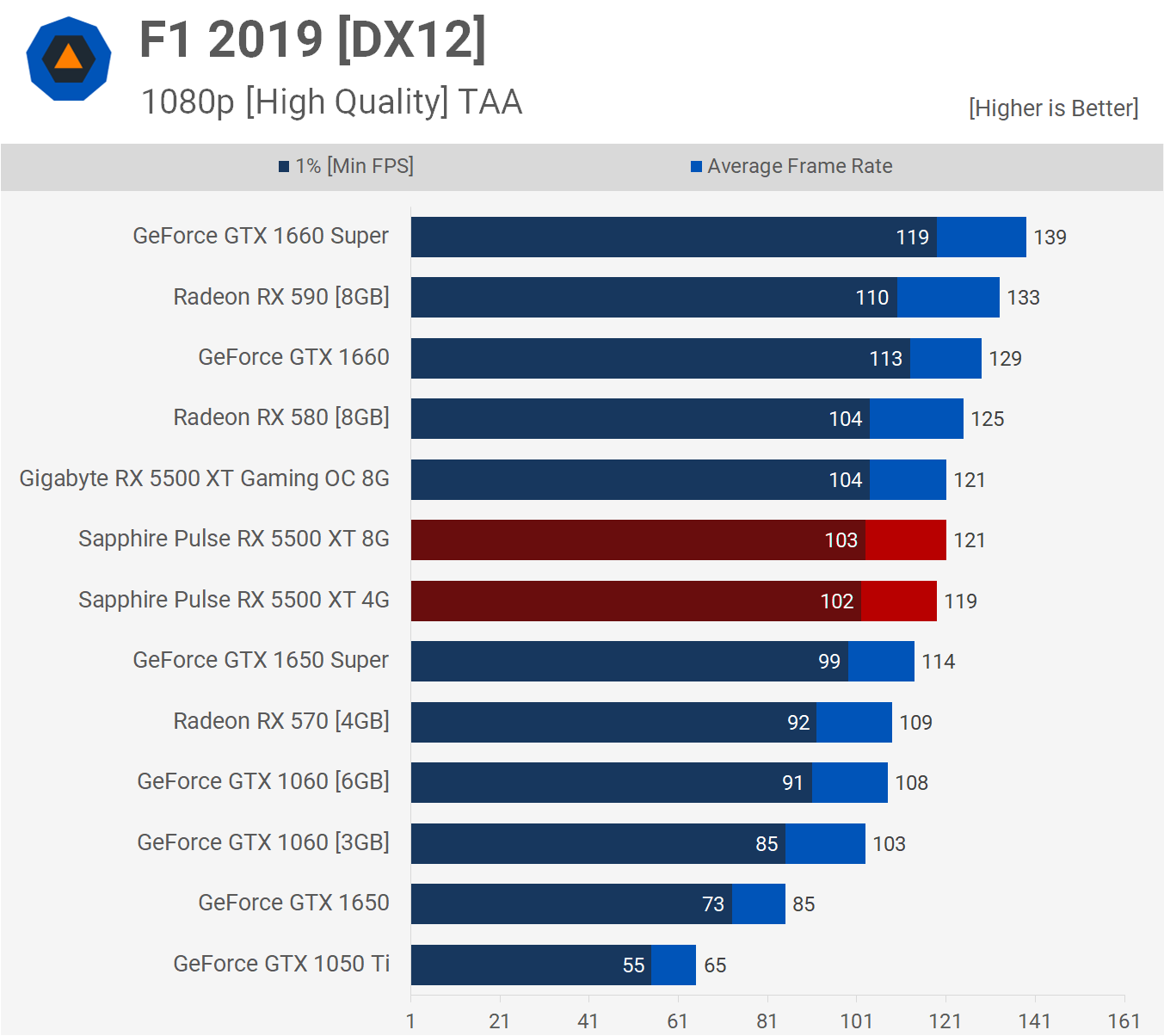
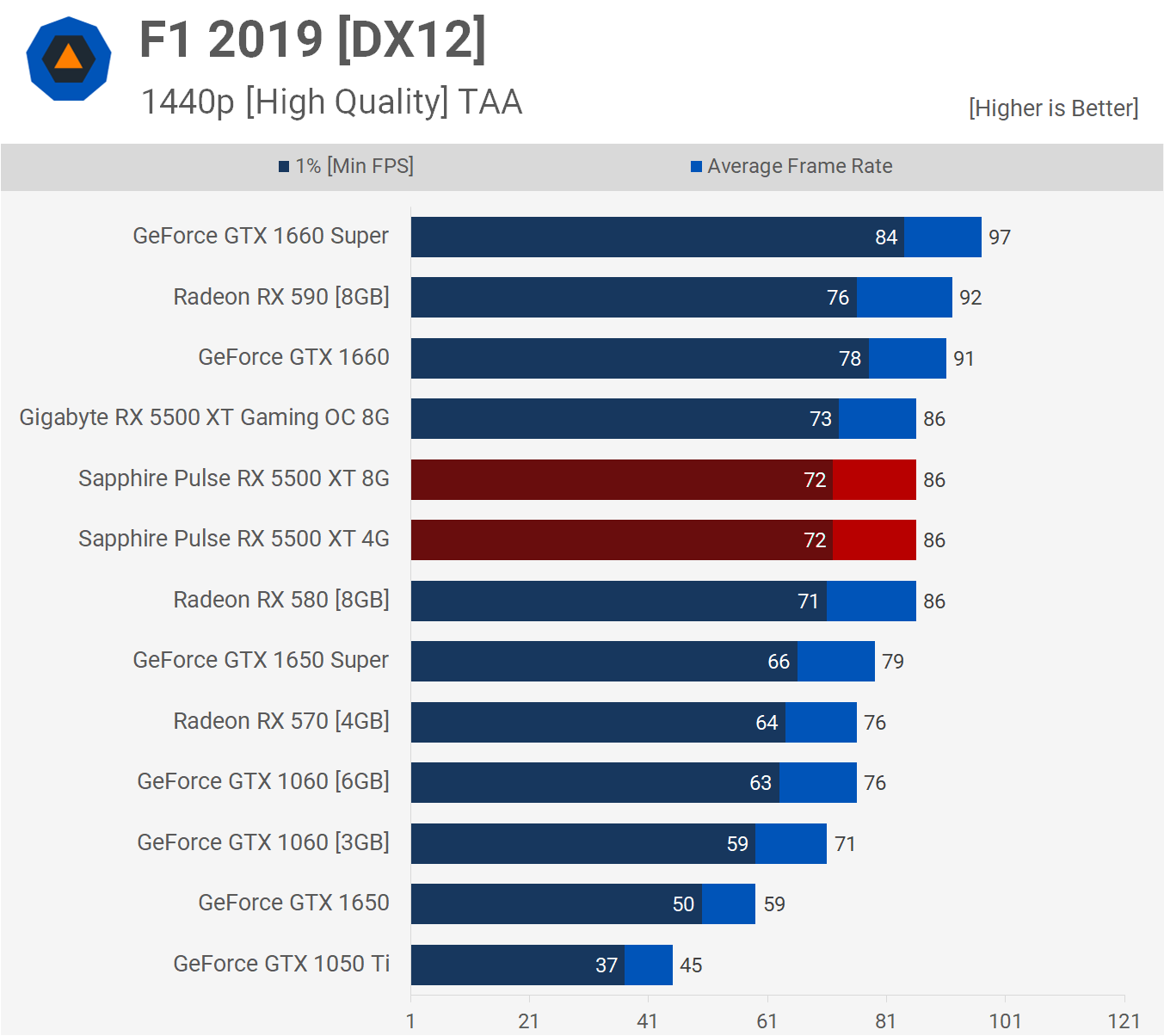
F1 2022 isn't memory intensive and as a outcome the 4 and 8GB versions of the 5500 XT enabled the same level of performance at 1080p. Information technology's the aforementioned state of affairs at 1440p, where the 4GB 5500 XT was good for 86 fps on average, the same functioning you'll receive from the RX 580.

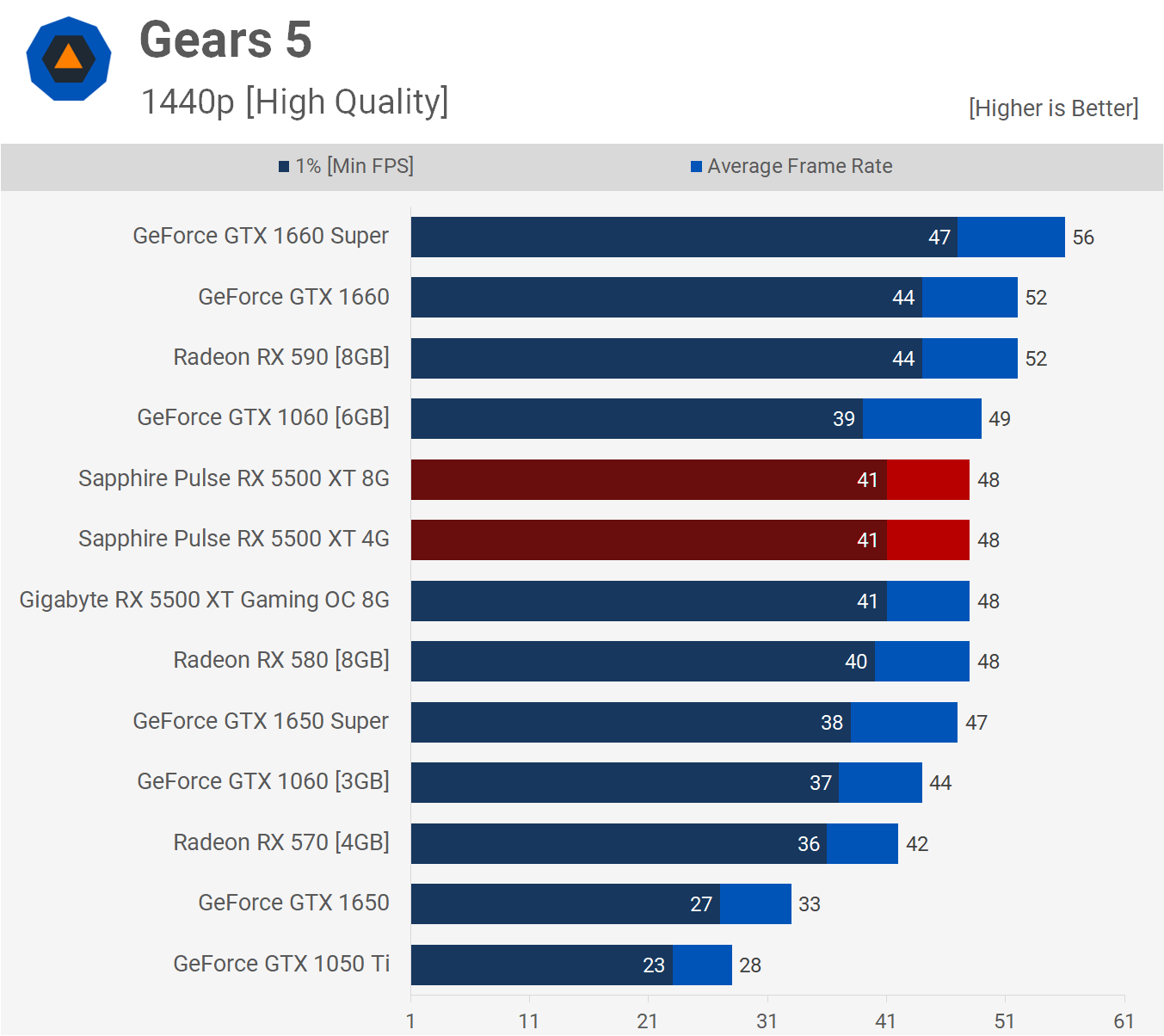
Last up nosotros have Gears 5, where we come across no operation difference betwixt the 4 and 8 GB versions of the 5500 XT. At 1440p, both models spat out 48 fps, which is the aforementioned level of performance delivered by the RX 580 and GTX 1650 Super.
Functioning Summary
Having looked at a dozen games tested at 1080p and 1440p, it's time to break all that data down. Let'south start by looking at the average performance on those 12 titles. These graphs don't tell the whole picture, merely nosotros'll apace take a look...

Looking at these results can be misleading equally information technology doesn't show when and how yous can run into trouble with the more limited 4GB VRAM buffer. Just overall, when taking all the games into account, the 4GB 5500 XT was but ~three.v% slower than the 8GB version and that placed it on par with the RX 580 and GTX 1650 Super.
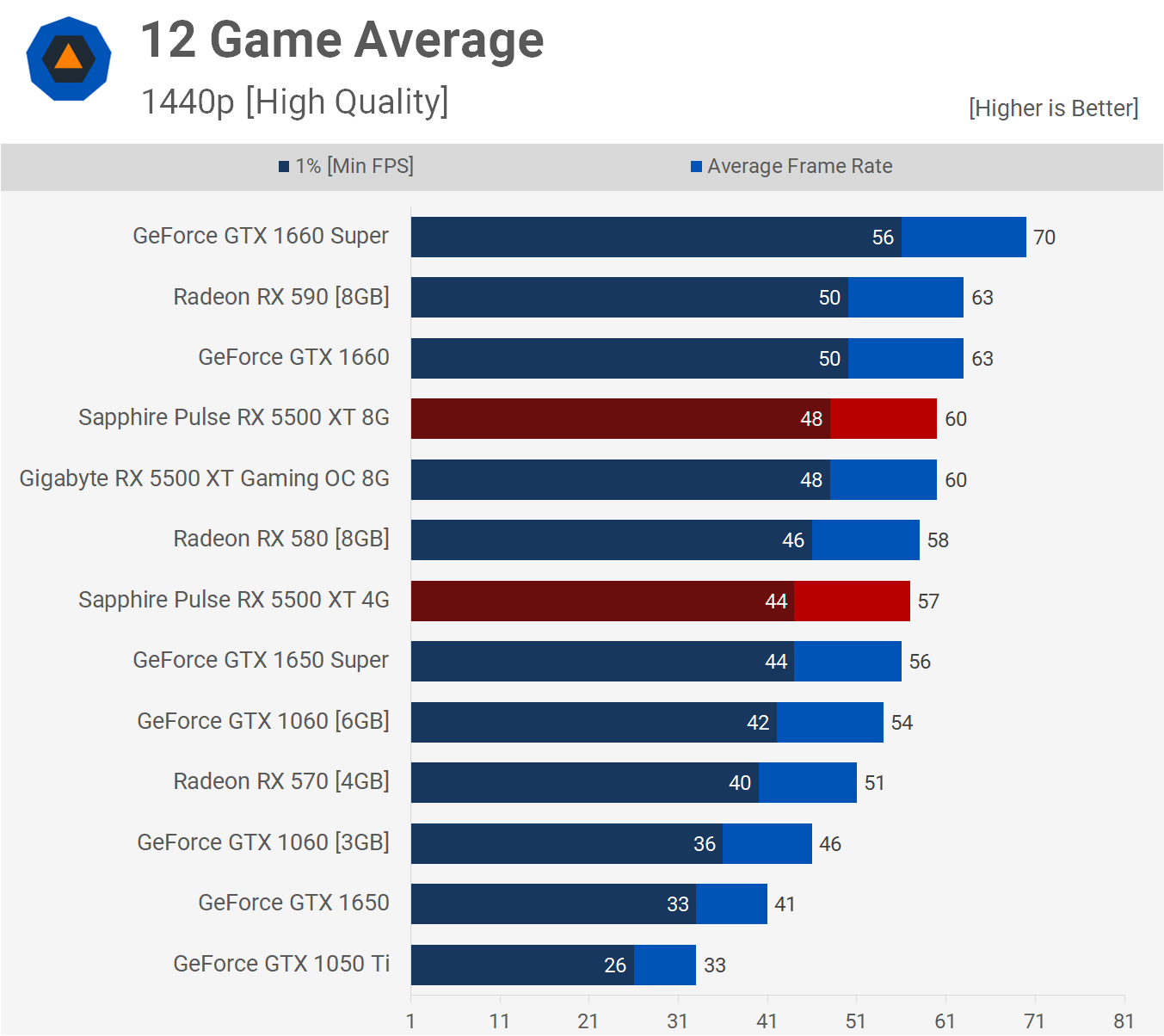
Nosotros see a similar story at 1440p, this time the 4GB 5500 XT was 5% slower on average when compared to the 8GB model, and again matched the RX 580 and GTX 1650 Super.
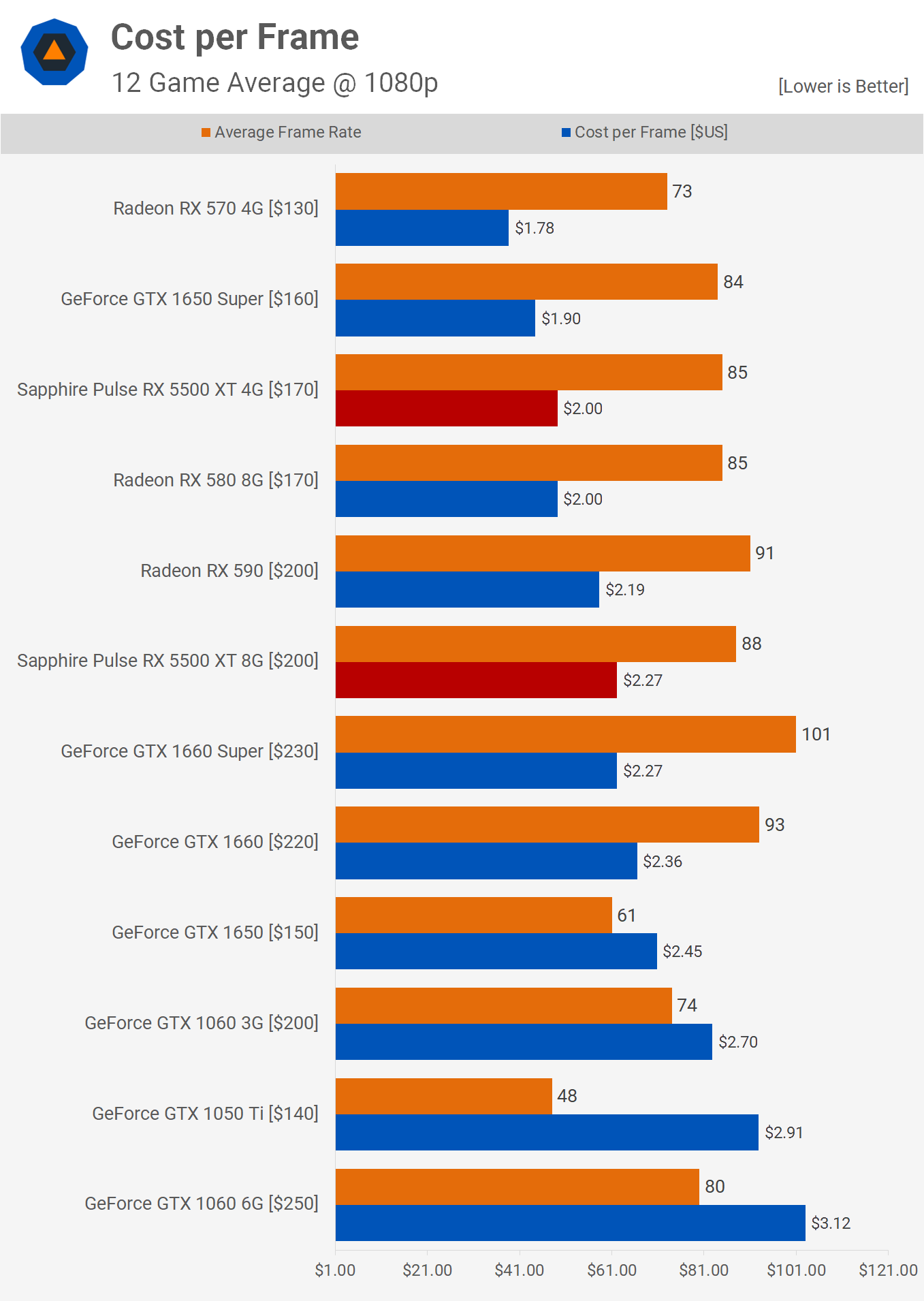
Taking the averages from the 1080p data we meet that the 4GB 5500 XT is able to match the cost per frame of the RX 580, so you're trading half the VRAM for a more efficient production and we'll discuss this in a moment.
For now the takeaway is that the GeForce GTX 1650 Super comes in v% cheaper per frame, which comes from the marginal ~$10 discount on MSRP.
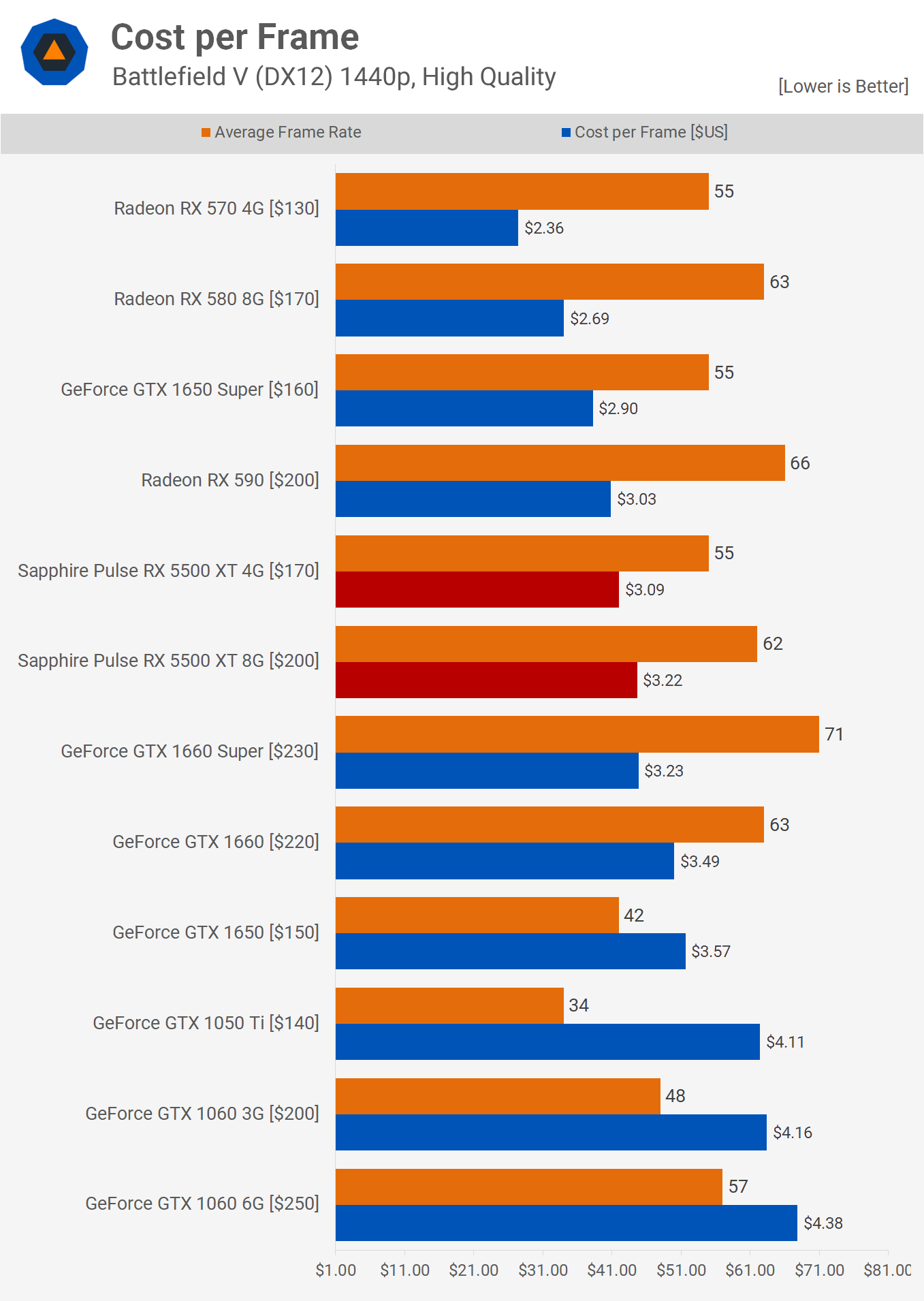
Yet things get worse for the RX 5500 if we look at a single title like Battleground 5. We're using the 1440p data here because information technology represents a state of affairs where the 4GB VRAM capacity starts to impact operation considerably, something you'll no uncertainty see more of in the side by side year or ii.
Where the difference between 4GB and 8GB of memory tin can be seen, the Radeon RX 580 is miles better in terms of value and the RX 570 is in another class, delivering the same operation equally the 4GB 5500 XT at a 24% discount per frame. This is probably the most telling graph we've looked at so far when evaluating the value of the 5500 XT.

Wrapping things up we accept a few RX 5500 XT 4GB vs. 8GB graphs that show the margins on a per game basis. Hither you can see that the 4GB model struggled in Call of Duty Modern Warfare, Shadow of the Tomb Raider and Red Expressionless Redemption two, while we saw modest performance driblet offs in Far Cry New Dawn, Assassin's Creed Odyssey and Metro Exodus, though they were then small in those titles information technology's really not worth talking about.

If we look at 1% low functioning we come across similar margins for the most part, though the 4GB version had a harder time in Assassin's Creed Odyssey.

At 1440p we come across no divergence between the 4GB and 8GB models for half the games tested, at least when comparing average frame rate functioning. The performance drop in Phone call of Duty was big, we as well meet a chip of a driblet in Assassin'due south Creed and double digit performance loses in Battlefield V and Shadow of the Tomb Raider.

The 1440p i% low data is the nigh telling graph for future performance. Nosotros see picayune to no impact for half the games tested, but the other half all see double digit hits to the frame rate with three titles dropping by more than 15%.
Ability Efficiency or More VRAM?
AMD's belatedly arrival with their mainstream Navi offerings may have to do with a 7nm supply effect. They're not in a position where they tin sell them in meaning enough quantities to justify being competitive on price. Equally things stand up right now, the GeForce GTX 1650 Super is a more compelling buy when compared to the 4GB 5500 XT. Overall, you're looking at basically the same level of performance, at a very small disbelieve. Looking at our small criterion sample of games, the GTX 1650 Super'south operation seemed more consistent, not suffering the larger functioning hits in titles such as Battlefield Five and Call of Duty Modernistic Warfare due to the more limited 4GB retention buffer.

If you're afterwards an efficient budget graphics bill of fare, the GTX 1650 Super looks like the way to get. However, in a recent poll nosotros asked what gamers preferred: ability efficiency or VRAM capacity, and as we suspected, an overwhelming number of yous picked memory capacity equally your preference.
That being the case, most of y'all spending less than $200 on your graphics carte may not be interested in the 4GB 5500 XT at $170 or the 4GB GTX 1650 Super at $160, when y'all can purchase an 8GB RX 580 for $170, sometimes as low every bit $150. The quondam Radeon uses substantially more than ability, but who cares? -- nosotros wouldn't -- and it seems a skilful portion of you lot agree.
It's worth noting that idle power consumption is about the same, and so while the RX 580 has the potential to run a hotter and louder when gaming, having that extra headroom with the retention seems more of import for about. And that means, as long as you tin can purchase the 2+ twelvemonth old discounted RX 580 8GB graphics card, for the same corporeality of coin as these newer 4GB GPUs, that's what nosotros'd practise. Had AMD priced the 8GB 5500 XT at no more than $170 and the 4GB model at around $140, then we feel they'd exist viable options, simply that just doesn't seem possible given the current supply constraints.
4GB vs. 8GB VRAM
Earlier wrapping up, let's talk a fiddling more about the 4GB vs. 8GB memory buffers...
There's a lot of fence around this topic. Many people claim 4GB merely isn't enough and graphics cards shouldn't be selling with such a limited retention capacity in 2022, while others claim 8GB is still overkill for 1080p gaming. In our stance, neither is right or wrong, it just depends, generally on what you plan on playing and how you lot plan on playing it.
Now, we exercise agree that $200 for a tiny GPU with a 128-scrap broad memory bus in late 2022 is likewise much, regardless of retentivity capacity, so we're certainly not attempting to justify RX 5500 XT or GTX 1650 Super pricing, nosotros're simply saying how much VRAM you require depends.
For example, if yous're a competitive gamer like myself who typically doesn't care about an immersive unmarried thespian experience with amazing graphics, then VRAM capacity doesn't really matter. For example, when I play Battlefield V, textures and most other quality settings aren't cranked upwards to ultra, instead almost all are set to depression which sees VRAM usage drib from around 5 GB downwardly to just 3 GB, and frankly the game still looks adept.
... for someone wanting to play Fortnite, spending more money to secure a card with more VRAM is simply a waste of coin.

It's the same for other games I play such equally Fortnite, Apex Legends and StarCraft 2, all those games are played with generally low quality settings, it just makes it easier to spot enemies and removes a lot of distracting effects. I'm not lone here either, this is how nearly gamers play esports/competitive titles, fifty-fifty those that aren't all that demanding to begin with.
In other words, for someone wanting to play Fortnite, spending more money to secure a menu with more VRAM is just a waste of coin.
Just if you are not into esports titles and prefer to play games like Assassin's Creed Odyssey and Shadow of the Tomb Raider for their stunning visuals and story manner, then ensuring that you have a graphics card with headroom in the VRAM department is more of import and probably worth paying a minor premium for.
If you're this sort of gamer, then you will want to avoid 4GB models like the plague, specially given the upcoming Xbox Series X volition have xvi GB of GDDR6 retentivity with 13GB accessible to games. Look the next generation of games to see a big pace up in memory usage.
If you're a gamer that enjoys single-player mode and stunning visuals, so you will want to avoid 4GB models similar the plague, especially given the upcoming Xbox Serial X will have sixteen GB of GDDR6 memory with 13GB accessible to games. Look the adjacent generation of games to see a big step upward in retention usage.

With all of that said, nosotros want to note that not having plenty VRAM isn't the disaster that some make information technology out to be. It's not close to say, having a dual-core processor and playing a game that requires a quad-cadre or better, in that scenario you're pretty much screwed and no matter how low you drop the quality settings, you're going to accept a bad time.
With express VRAM, all you have to practise is drop texture quality settings down and you're abroad. Sure, the game might not wait equally skillful, just it's however going to exist playable and in a brand-do scenario that's all you can promise for. Also how a title handles insufficient VRAM will depend on the game. Some turn into a slide show until y'all reduce memory usage, others won't even permit you utilize the higher quality settings (Red Expressionless Redemption 2), and some will automatically reduce or remove textures entirely, often leaving you with a blurry mess.
Providing a more than affordable option with less memory for coincidental or competitive gamers isn't a bad affair, you but don't want to exist paying most $200 for a cut down option correct now. Equally we said before, had the 4GB 5500 XT come up in at ~$140 then it would have been a pretty solid deal, but as things stand up today, you're better off with an 8GB RX 580, finish of story.
Shopping Shortcuts:
- AMD Radeon RX 580 on Amazon
- AMD Radeon RX 590 on Amazon
- AMD Radeon RX 5500 XT on Amazon
- GeForce GTX 1650 Super on Amazon
- GeForce GTX 1660 Super on Amazon
- GeForce GTX 1660 Ti on Amazon
- GeForce RTX 2060 Super on Amazon
- AMD Radeon RX 5700 XT on Amazon
- AMD Radeon RX 5700 on Amazon
- GeForce RTX 2070 Super on Amazon
- AMD Ryzen v 3600 on Amazon
Source: https://www.techspot.com/review/1961-radeon-rx-5500-4gb-vs-8gb/
Posted by: ortiztheatanthe.blogspot.com


0 Response to "AMD Radeon RX 5500 XT 4GB vs. 8GB"
Post a Comment